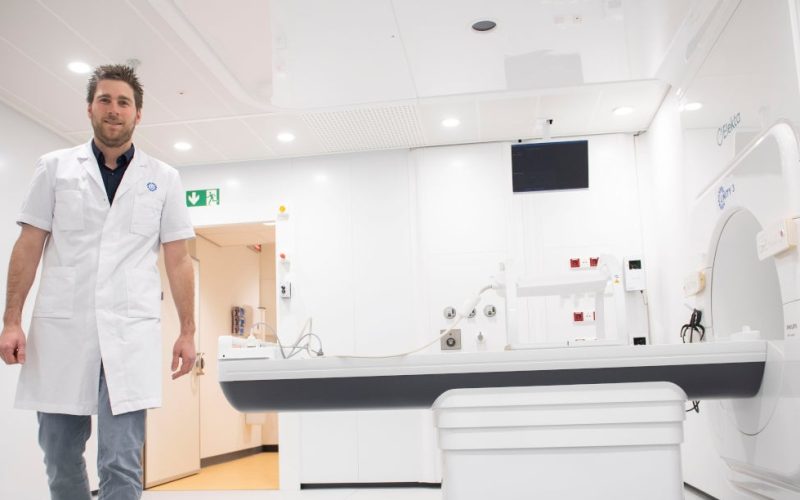With effect from 15 March 2023, UMC Utrecht has appointed Martijn Intven as professor of image-guided radiotherapy. This new chair falls within the Strategic Program Cancer and the Imaging Division of UMC Utrecht.
His new position fits Martijn like a glove. Ever since graduating in medicine in Leuven (2009), he has been fully focused on using image-guided interventions to optimize the effects of cancer treatment. In 2009, he joined UMC Utrecht as a PhD student, researching how to apply MR imaging to predict the response of rectal cancer patients to radiotherapy treatment. Two years later, he also started his radiotherapy residency here. Having earned his PhD in 2015, and his registration as a medical specialist in radiotherapy in 2016, he stayed on at UMC Utrecht, both as a radiotherapist-oncologist and a researcher. From the beginning, Martijn was, for instance, involved in the clinical introduction of the 1.5T MR-linac as of 2018. This revolutionary machine was invented by UMC Utrecht. It uses MRI images to adapt the radiation field to the precise location of the tumour and the surrounding healthy tissue and organs. As a result, tumours can be attacked with higher precision, even when they are moving a lot, due to breathing or peristaltic movements.
Martijn has coordinated the use of the MR-linac in the treatment of various tumour types, including rectal and pancreatic cancer. Since then, the MR-linac has also been introduced outside Utrecht and is now used in other Dutch hospitals. And it has crossed borders, having become a standard procedure in medical centres all over the world to treat different types of cancer. This is more than logical, as the machine has made radiotherapy less demanding for patients. That is, the high precision of the MR-linac ensures that surrounding healthy tissue is less affected. Furthermore, patients can receive a higher dose of radiotherapy at a time, so they don’t have to visit hospital as often as before. Plus: with some tumour types, it is now safe to administer a higher total dose of radiation, increasing the chance of controlling the tumour. “If we can give patients a higher dose with more precision, we will be able achieve more and more satisfying results with many tumour types. We will then even accomplish results comparable to surgery. Consequently, in the near future, we expect radiotherapy to become a non-invasive alternative to surgery for some tumours”, Martijn says.
The MR-linac is now used with prostate, rectal, pancreatic, kidney, lung and gynaecological tumours, and with metastases in the liver, adrenal glands and lymph nodes. Martijn aims to make every radiotherapy treatment more precise in the future. Not only by optimizing MR-linac treatments, but also by, for instance, improving CT-guided techniques. Martijn: “We are now conducting several studies regarding the response prediction strategy of the MR-linac. Which patient will benefit from MR-guided radiotherapy? And which one will need direct surgery? These studies now primarily revolve around prostate, rectal and pancreatic cancer but will be extended to other tumour types.” Martijn’s research is fundamental to personalizing cancer treatment: for each individual, specialists will increasingly determine which treatment will fit him/her the most, instead of opting for the same, standardized therapy for all cancer patients, as we used to do. Personalized cancer treatment is one of the main objectives of the Strategic Program Cancer, in order to improve patients’ survival rate and quality of life.
UMC Utrecht’s cancer research is internationally renowned. ‘Image science and image guided interventions ‘ is one of the three major research areas of the Strategic Program Cancer: how can we improve cancer therapies by means of image-guided science? Furthermore, UMC Utrecht is a world-leading knowledge and healthcare institution regarding image-guided interventions for non-malignant diseases. So, Martijn’s chair comes naturally. With his appointment, UMC Utrecht can speed up oncological image-guided interventions. Plus: Martijn’s chair is completely in line with one of the major overall goals of UMC Utrecht: by 2025, image-guided interventions should have become the standard to battle not only cancer but many other diseases. Martijn: “For image-guided radiotherapy, this is just the beginning. We expect interventions to be much more precise and personalized in the near future, based on the MRI-images we are now retrieving before and during treatment.”
